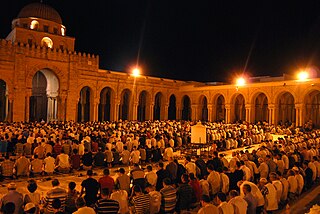
Zakat is a form of almsgiving treated in Islam as a religious obligation or tax, which, by Quranic ranking, is next after prayer (salat) in importance.

The Umayyad Caliphate was the second of the four major caliphates established after the death of Muhammad. The caliphate was ruled by the Umayyad dynasty. The third caliph of the Rashidun Caliphate, Uthman ibn Affan, was also a member of the Umayyad clan. The family established dynastic, hereditary rule with Muawiya ibn Abi Sufyan, long-time governor of al-Sham, who became the sixth caliph after the end of the First Muslim Civil War in 661. After Mu'awiyah's death in 680, conflicts over the succession resulted in a Second Civil War and power eventually fell into the hands of Marwan I from another branch of the clan. The region of Syria remained the Umayyads' main power base thereafter, and Damascus was their capital.

Omar, also spelled Umar ; Arabic: عمر بن الخطاب ʿUmar ibn al-Khaṭṭāb[ˈʕomɑr-, ˈʕʊmɑr ɪbn alxɑtˤˈtˤɑːb], "Umar, Son of Al-Khattab"; c. 584 CE – 3 November 644 CE), was one of the most powerful and influential Muslim caliphs in history. He was a senior companion of the Islamic prophet Muhammad. He succeeded Abu Bakr (632–634) as the second caliph of the Rashidun Caliphate on 23 August 634. He was an expert Muslim jurist known for his pious and just nature, which earned him the epithet Al-Farooq. He is sometimes referred to as Omar I by historians of early Islam, since a later Umayyad caliph, Umar II, also bore that name.

Muawiyah I was the founder and first caliph of the Umayyad Caliphate, serving from 661 until his death. He became caliph less than 30 years following the death of the Islamic prophet Muhammad and very shortly after the reign of the four "rightly guided" (Rashidun) caliphs. Although considered to be lacking in the justice and piety of the Rashidun, Muawiyah was also the first caliph whose name appeared on coins, inscriptions, or documents of the nascent Islamic empire.

Ali ibn Abi Talib was a cousin and son-in-law of the Islamic prophet Muhammad, who ruled as the fourth caliph from 656 until his assassination in 661. He is one of the central figures in Shia Islam and is regarded as the rightful immediate successor to Muhammad as an Imam by Shia Muslims.

Umar ibn Abd al-Aziz, commonly known as Umar II, was the eighth Umayyad caliph. He made various significant contributions and reforms to the society, and he has been described as "the most pious and devout" of the Umayyad rulers and was often called the first Mujaddid and fifth righteous caliph of Islam.

The Rashidun Caliphates, often simply called, collectively, "the Rashidun", are the spiritual and political successors to the Islamic prophet Muhammad in the Sunni jurisprudence of Islam, refers to the 30-year reign (632–661) of the first four caliphs (successors) following the death of Muhammad, namely: Abu Bakr, Umar, Uthman ibn Affan, and Ali of the Rashidun Caliphate, the first caliphate. The caliphate of Hasan ibn Ali is sometimes also considered to be Rashidun as well but since it was merely a six month period it is not mentioned categorically. It is a reference to the Sunni imperative "Hold firmly to my example (sunnah) and that of the Rightly Guided Caliphs".

A caliphate is an Islamic state under the leadership of an Islamic steward with the title of caliph, a person considered a politico-religious successor to the Islamic prophet Muhammad and a leader of the entire Muslim world (ummah). Historically, the caliphates were polities based on Islam which developed into multi-ethnic trans-national empires. During the medieval period, three major caliphates succeeded each other: the Rashidun Caliphate (632–661), the Umayyad Caliphate (661–750), and the Abbasid Caliphate (750–1517). In the fourth major caliphate, the Ottoman Caliphate, the rulers of the Ottoman Empire claimed caliphal authority from 1517. Throughout the history of Islam, a few other Muslim states, almost all hereditary monarchies such as the Mamluk Sultanate (Cairo) and Ayyubid Caliphate, have claimed to be caliphates.

In Islam, khums refers to the required religious obligation of any Muslims to pay one-fifth of their acquired wealth from certain sources toward specified causes. It is treated differently in Shia and Sunni Islam. This tax is paid to the imam, caliph or sultan, representing the state of Islam, for distribution between the orphans, the needy, and the [stranded] traveler.

Tarawih refers to additional ritual prayers performed by Muslims at night after the Isha prayer during the holy month of Ramadan. It may involve reading one Juz', and usually is 8 or 10 raka'at, lasting well over an hour in total. According to some scholars, one performs 20 rakats. Unlike the five daily salat ritual prayers which are fard (obligatory) under Islamic law, tarawih is from the sunnah.

Ali was the cousin and son-in-law of the Islamic prophet Muhammad, and a member of the Ahl al-Bayt. Shias regard Ali as the first Imam and consider him, along with his descendants, to be one of the divinely appointed successors of Muhammad who are claimed by the Shia of the Muslim community. Although Ali was regarded, during the lifetime of Muhammad, as his initial successor, it would be 25 years before he was recognized with the title of Caliph (successor). Like the rest of his household, Shias claim that Ali is infallible and sinless and is one of The Fourteen Infallibles of the household of Muhammed.
The hadith of the twelve successors, or twelve caliphs is an Islamic prophecy, attributed to Muhammad. It is most popular among Twelver Shi'ites, as they interpret the prophecy was fulfilled by the Twelve Imams. The hadith is widely accepted by all Muslims, but its interpretation varies heavily.
Ubayy ibn Ka'b, also known as Abu Mundhir, was a companion of the Islamic prophet Muhammad and a person of high esteem in the early Muslim community.

Bayt al-mal is an Arabic term that is translated as "House of money" or "House of Wealth." Historically, it was a financial institution responsible for the administration of taxes in Islamic states, particularly in the early Islamic Caliphate. It served as a royal treasury for the caliphs and sultans, managing personal finances and government expenditures. Further, it administered distributions of zakat revenues for public works. Modern Islamic economists deem the institutional framework appropriate for contemporary Islamic societies.
Muhammad ibn Maslamah was a companion of the Islamic prophet Muhammad. He was known as "The Knight of Allah's Prophet".
The Ansar were the local inhabitants of Medina who, in Islamic tradition, took the Islamic prophet Muhammad and his followers into their homes when they emigrated from Mecca during the hijra.

The Rashidun Caliphate was the first of the four major caliphates established after the death of the Islamic prophet Muhammad. It was ruled by the first four successive caliphs (successors) of Muhammad after his death in 632 CE. These caliphs are collectively known in Sunni Islam as the Rashidun, or "Rightly Guided" caliphs.
Shi‘a Islam, also known as Shi‘ite Islam or Shi‘ism, is the second largest branch of Islam after Sunni Islam. Shias adhere to the teachings of Muhammad and the religious guidance of his family or his descendants known as Shia Imams. Muhammad's bloodline continues only through his daughter Fatima Zahra and cousin Ali who alongside Muhammad's grandsons comprise the Ahl al-Bayt. Thus, Shias consider Muhammad's descendants as the true source of guidance. Shia Islam, like Sunni Islam, has at times been divided into many branches; however, only three of these currently have a significant number of followers, and each of them has a separate trajectory.
`Ubadah ibn al-Samit was a companion of Muhammad and a well-respected chieftain of the Ansar tribes confederation, who participated in almost every battle during Muhammad's era. His official title, according to Muslim scholarly tradition, was Ubadah bin Saamit al-Ansari al-Badri for his actions at the Battle of Badr. He served under the first three Rashidun caliphs in the Muslim conquest against the Byzantines.
Islam is an Abrahamic monotheistic religion teaching that there is only one God (Allah) and that Muhammad is His last Messenger.











